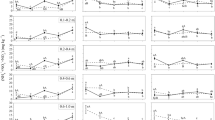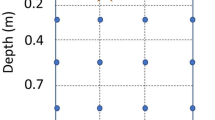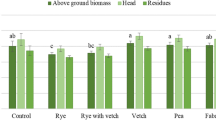Abstract
To reduce greenhouse gas emissions farmers are being encouraged not to burn sugarcane residues. An experiment was set up in NE Thailand, where sugarcane residues of the last ratoon crop were either burned, surface mulched or incorporated and subsequently the field left fallow or planted to groundnut or soybean. The objectives of the current experiment were to evaluate the residual effects of these treatments during the following new sugarcane crop on (i) microbial and mineral N dynamics, (ii) performance of sugarcane and (iii) effectiveness of recycled legume residues compared to mineral N fertilizer on N use efficiencies, 15N recovery in the system and in soil particle size and density fractions (using 15N labelled legume residues and fertilizer). The millable cane and sugar yield were positively affected by sugarcane residue mulching and incorporation compared to burning suggesting microbial remobilization of previously immobilized N. Residual effects of legumes increased sugarcane tillering and yield (127 and 116 Mg ha−1 for groundnut and soybean, respectively) compared to the fallow treatment without N fertilizer (112 Mg ha−1). Soybean residues of higher C:N ratio (33:1) and lignin content (13%) compared to groundnut residues (21:1 C:N, 5% lignin) decomposed slower and improved N synchrony with cane N demand. This led to a better conservation of residue N in the system with proportionally less 15N losses (15–17%) compared to the large losses from groundnut residues (50–57%) or from mineral N fertilizer (50–63%). 15N recoveries in soil were larger from residues (41–80%) than from fertilizer (30%) at final harvest. Recycled legume residues were able to substitute basal fertilizer N application but not topdressing after 6 months.




Similar content being viewed by others
References
Amato M, Ladd JN (1988) Assay for microbial biomass based on ninhydrin reactive nitrogen in extracts of fumigated soil. Soil Biol Biochem 20:107–114. doi:10.1016/0038-0717(88)90134-4
Analytical Software (2003) Statistix 8: user’s manual. Analytical Software, Tallahassee
Andersen JM, Ingram JSI (1993) Tropical soil biology and fertility: a handbook of methods. CABI Publishing, Wallingford
Ando S, Meunchang S, Thippayarugs S, Prasertsak P, Matsumoto N, Yoneyama T (2002) Evaluation of sustainability of sugarcane production in Thailand based on nitrogen fixation, efficiency of nitrogen fertilizer and flow of organic matter. In: Ito O, Matsumoto N (eds) Development of sustainable agricultural system in northeast Thailand through local resources utilization and technology improvement. JIRCAS Working Report, Khon Kaen, Thailand, pp 61–64
Ball Coelho B, Tiessen H, Stewart JWB, Salcedo IH, Sampaio EVSB (1993) Residue management effects on sugarcane yield and soil properties in northeastern Brazil. Agron J 85:1004–1008
Basanta MV, Dourado-Neto D, Reidchardt K, Bacchi OOS, Oliveira JCM, Trivelin PCO et al (2003) Management effects on nitrogen recovery in a sugarcane crop grown in Brazil. Geoderma 116:235–248. doi:10.1016/S0016-7061(03)00103-4
Courtaillac N, Baran R, Oliver R, Casabianca H, Ganry F (1998) Efficiency of nitrogen fertilizer in sugarcane-vertical system in Guadeloupe according to growth and ratoon age of the cane. Nutr Cycl Agroecosyst 5:9–17. doi:10.1023/A:1009765302105
De Resende AS, Xavier RP, de Oliveira OC, Urquiaga S, Alves BJR, Boddey RM (2006) Long-term effects of pre-harvest burning and nitrogen and vinasse applications on yield of sugar cane and soil carbon and nitrogen stock on a plantation in Pernambuco, NE Brazil. Plant Soil 281:339–351. doi:10.1007/s11104-005-4640-y
Eagle AJ, Brid JA, Hill JE, Horwath WR, van Kessel C (2001) Nitrogen dynamics and fertilizer use efficiency in rice following straw incorporation and winter flooding. Agron J 93:1346–1354
Freney JR, Denmead OT, Wood AW, Saffigna PG, Chapman LS, Ham GJ et al (1992) Factors controlling ammonia loss from trash covered sugarcane fields fertilized with urea. Nutr Cycl Agroecosyst 31:341–349
Giller KE, Cadisch G (1995) Future benefits from biological nitrogen fixation in agriculture: an ecological approach. Plant Soil 174:255–277. doi:10.1007/BF00032251
Giller KE, Nambiar PTC, Srinivasa Rao B, Dart PJ, Day JM (1987) A comparison of nitrogen fixation in genotypes of groundnut (Arachis hypogaea L.) using 15N-isotope dilution. Biol Fertil Soils 5:23–25. doi:10.1007/BF00264341
Giller KE, Cadisch G, Palm C (2002) The north–south divide! Organic wastes, or resources for nutrient management? Agronomie 22:703–709. doi:10.1051/agro:2002058
Graham MH, Haynes RJ (2005) Organic matter accumulation and fertilizer-induced acidification interact to affect soil microbial and enzyme activity on a long-term sugarcane management experiment. Biol Fertil Soils 41(4):249–256. doi:10.1007/s00374-005-0830-2
Gülser F (2005) Effects of ammonium sulphate and urea on NO3 − and NO2 − accumulation, nutrient contents and yield criteria in spinach. Sci Hortic 106(3):330–340. doi:10.1016/j.scienta.2005.05.007
Hemwong S, Cadisch G, Toomsan B, Limpinuntana V, Vityakon P, Patanothai A (2008) Dynamics of residue decomposition and N2 fixation of grain legumes upon sugarcane stover retention as an alternative to burning. Soil Tillage Res 99:84–97. doi:10.1016/j.still.2008.01.003
Hunsigi G (1993) Production of sugarcane, theory and practice. Springer-Verlag, Berlin
International Commission for Uniform Methods of Sugar Analysis (1994) Method GS 5/7-1. Norwich, England
Ma BL, Dwyer LM, Gregorich EG (1999) Soil nitrogen amendment effects on nitrogen uptake and grain yield of maize. Agron J 91:650–656
Ng Kee Kwong KF, Deville J (1994) The course of fertilizer nitrogen uptake by rainfed sugarcane in Mauritius. J Agric Sci 122:385–391
Norman RJ, Gilmour JT, Wells BR (1990) Mineralization of nitrogen from nitrogen-15 labeled crop residues and utilization by rice. Soil Sci Soc Am J 54:1351–1356
Palm CA, Gachego C, Delve R, Cadisch G, Giller KE (2001) Organic inputs for soil fertility management in tropical agroecosystems: application of an organic resource database. Agric Ecosyst Environ 83:27–42. doi:10.1016/S0167-8809(00)00267-X
Pankhurst CE, Blair BL, Magarey RC, Stirling GR, Bell MJ, Garside AL (2005) Effect of rotation breaks and organic matter amendments on the capacity of soils to develop biological suppression towards soil organisms associated with yield decline of sugarcane. Appl Soil Ecol 28:271–282. doi:10.1016/j.apsoil.2004.07.010
Promsakha Na Sakonnakhon S, Toomsan B, Cadisch G, Baggs EM, Vityakon P, Limpinuntana V et al (2005) Dry season groundnut stover management practices determine nitrogen cycling efficiency and subsequent maize yields. Plant Soil 272:183–199. doi:10.1007/s11104-004-4780-5
Promsakha Na Sakonnakhon S, Cadisch G, Toomsan B, Vityakon P, Limpinuntana V, Jogloy S et al (2006) Weeds-friend or foe? The role of weed composition on stover nutrient recycling efficiency. Field Crops Res 97:238–247. doi:10.1016/j.fcr.2005.10.006
Segda Z, Haefele SM, Wopereis MCS, Sedogo MP, Guinko S (2004) Agro-economic characterization of rice production in a typical irrigation scheme in Burkina Faso. Agron J 96:1314–1322
Smith CJ, Wright GC, Woodroofe MR (1988) The effect of irrigation and nitrogen fertilizer on rapeseed (Brassica napus) production in south-eastern Australia. II. Nitrogen accumulation and oil yield. Irrig Sci 9:15–25. doi:10.1007/BF00292140
Suman A, Lal M, Singh AK, Gaur A (2006) Microbial biomass turnover in Indian subtropical soils under different sugarcane intercropping systems. Agron J 98:698–704. doi:10.2134/agronj2005.0173
Svecnjak Z, Rengel Z (2006) Canola cultivars differ in nitrogen utilization efficiency at vegetative stage. Field Crops Res 97:221–226. doi:10.1016/j.fcr.2005.10.001
Takahashi DT (1970) Fate of unrecovered fertilizer nitrogen in lysimeter studies with 15N. Hawaii Plant Rec 58:95–101
Tecator (1984) Determination of ammonia nitrogen (ASN 65-32/84) or nitrate nitrogen (ASN 65-31/84) in soil samples extractable by 2 M KCl using flow injection analysis. Application notes. Tecator, Höganas, Sweden
Toomsan B, McDonagh JF, Limpinuntana V, Giller KE (1995) Nitrogen fixation by groundnut and soybean and residual nitrogen benefits to rice in farmer’s fields in northeast Thailand. Plant Soil 175:45–56. doi:10.1007/BF02413009
Vallis I, Parton WJ, Keating BA, Wood AW (1996) Simulation of the effects of trash and N fertilizer management on soil organic matter levels and yields of sugarcane. Soil Tillage Res 38:115–132. doi:10.1016/0167-1987(96)01014-8
Vityakon P, Meepech S, Cadisch G, Toomsan B (2000) Soil organic matter and nitrogen transformation mediated by plant residues of different qualities in sandy acid upland and paddy soil. Neth J Agric Sci 48:75–90
Wiedenfeld RP (1998) Previous-crop effects on sugarcane response to nitrogen fertilization. Agron J 90:161–165
Wood AW (1991) Management of crop residues following green harvesting of sugarcane in north Queensland. Soil Tillage Res 20:69–85. doi:10.1016/0167-1987(91)90126-I
Acknowledgements
The research reported here was funded by the Royal Golden Jubilee Ph.D. Program and the Senior Research Scholar Project of Prof. Dr. Aran Patanothai under the Thailand Research Fund, Thailand and the Special Research Programme (SFB 564) from DFG (Deutsche Forschungsgemeinschaft), Germany.
Author information
Authors and Affiliations
Corresponding author
Rights and permissions
About this article
Cite this article
Hemwong, S., Toomsan, B., Cadisch, G. et al. Sugarcane residue management and grain legume crop effects on N dynamics, N losses and growth of sugarcane. Nutr Cycl Agroecosyst 83, 135–151 (2009). https://doi.org/10.1007/s10705-008-9209-8
Received:
Accepted:
Published:
Issue Date:
DOI: https://doi.org/10.1007/s10705-008-9209-8




